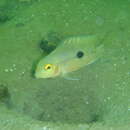Diagnostic Description
provided by Fishbase
This species can be distinguished by the dark line running through the middle of the body and the large black blotch positioned midlength; head profile extremely curved with the mouth on the lower part of the head; in males, the scales have dark edges producing a reticulated pattern, their fins with many dark spots, and a red edge to the dorsal fin; both males with iridescent, greenish-blue head and with gold to copper-colored bodies (Ref. 44091).
- Recorder
- Crispina B. Binohlan
Life Cycle
provided by Fishbase
Deposits eggs in sand depressions. Produces about 200-400 non adhesive eggs with females practicing communal care during the post spawning period (an unusual behavior referred to as "creching", Ref. 44091). A group of 3 or 4 females stand guard over their combined spawns, encircling the expanded group and do not allow any intruders or predators into the rearing arena.
Morphology
provided by Fishbase
Dorsal spines (total): 18 - 19; Dorsal soft rays (total): 9 - 11; Anal spines: 7 - 8; Analsoft rays: 7 - 9
- Recorder
- Crispina B. Binohlan
Trophic Strategy
provided by Fishbase
Inhabits lakes and slow moving rivers with moderate currents. Juveniles feed on aquatic insects, while adults feed on bottom detritus, seeds and leaves. Also naturally feed on snails and other mollusks, but will accept a variety of food in captivity (Ref. 44091).
- Recorder
- Drina Sta. Iglesia
Biology
provided by Fishbase
Inhabit lakes and rivers with slow to moderate currents, between 5 to 200 m elevation (Ref. 36880). Juveniles feed on aquatic insects, while adults feed on bottom detritus, seeds and leaves. Also naturally feed on snails and other mollusks, but will accept a variety of food in captivity (Ref. 44091). Maximum length 25 cm TL (Ref. 2060).
Importance
provided by Fishbase
fisheries: of no interest; aquarium: commercial
Hypsophrys nicaraguensis
provided by wikipedia EN
Hypsophrys nicaraguensis, the moga, is a species of cichlid native to the Atlantic slope of Central America, from Nicaragua to Costa Rica.[1] The species is a popular aquarium fish and is traded under a variety of common names that include nickie, parrot cichlid, macaw cichlid, butterfly cichlid and nicaraguense.[1] In Costa Rica it is known as a vieja.[2]
Feeding
Hypsophrys nicaraguensis is able to protrude its jaw to 3.8% of its standard length limiting its diet to only 1% evasive prey.[3]
Classification
The species was formerly the only representative of its genus, and is part of family Cichlidae in subfamily Cichlasomatinae.[1] However, the Poor man's tropheus, formerly Neetroplus nematopus, has also been placed into the genus Hypsophrys, as Hypsophrys nematopus.[4]
Conservation
It occurs in the Maquenque National Wildlife Refuge.[2]
References

- license
- cc-by-sa-3.0
- copyright
- Wikipedia authors and editors
Hypsophrys nicaraguensis: Brief Summary
provided by wikipedia EN
Hypsophrys nicaraguensis, the moga, is a species of cichlid native to the Atlantic slope of Central America, from Nicaragua to Costa Rica. The species is a popular aquarium fish and is traded under a variety of common names that include nickie, parrot cichlid, macaw cichlid, butterfly cichlid and nicaraguense. In Costa Rica it is known as a vieja.
- license
- cc-by-sa-3.0
- copyright
- Wikipedia authors and editors

